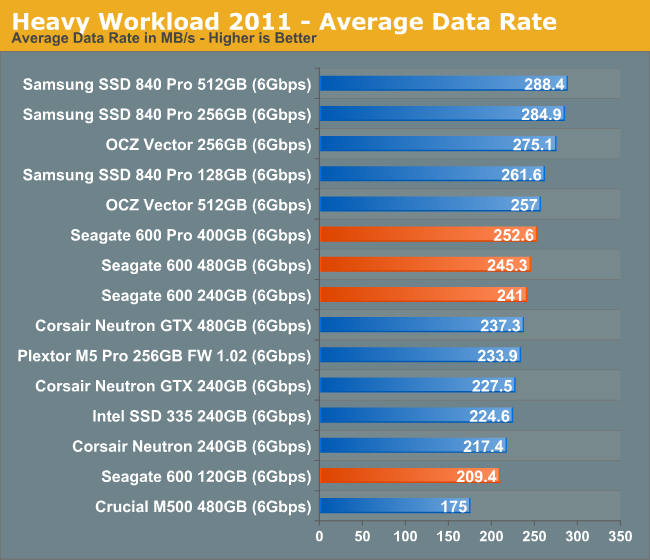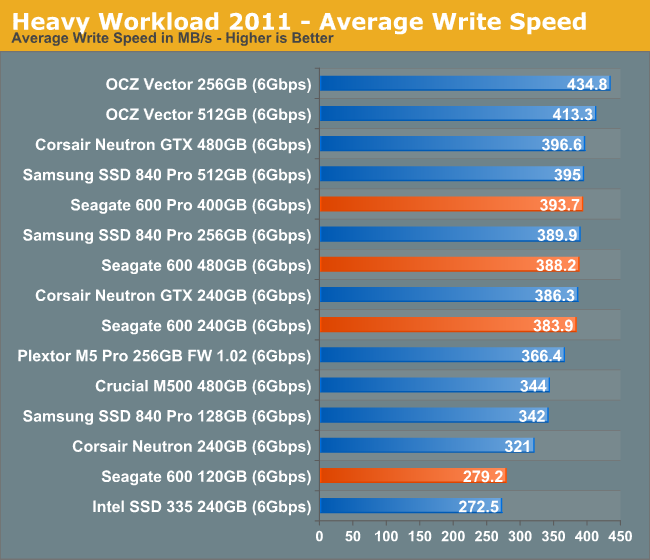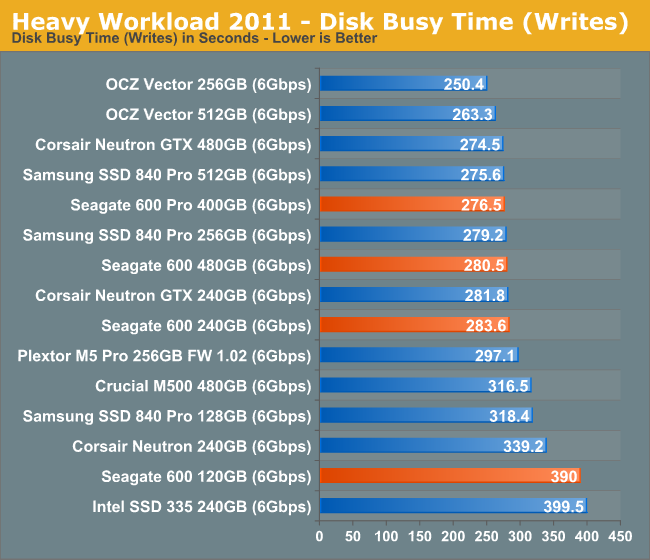The Seagate 600 & 600 Pro SSD Review
by Anand Lal Shimpi on May 7, 2013 8:00 AM ESTAnandTech Storage Bench 2011
Two years ago we introduced our AnandTech Storage Bench, a suite of benchmarks that took traces of real OS/application usage and played them back in a repeatable manner. I assembled the traces myself out of frustration with the majority of what we have today in terms of SSD benchmarks.
Although the AnandTech Storage Bench tests did a good job of characterizing SSD performance, they weren't stressful enough. All of the tests performed less than 10GB of reads/writes and typically involved only 4GB of writes specifically. That's not even enough exceed the spare area on most SSDs. Most canned SSD benchmarks don't even come close to writing a single gigabyte of data, but that doesn't mean that simply writing 4GB is acceptable.
Originally I kept the benchmarks short enough that they wouldn't be a burden to run (~30 minutes) but long enough that they were representative of what a power user might do with their system.
Not too long ago I tweeted that I had created what I referred to as the Mother of All SSD Benchmarks (MOASB). Rather than only writing 4GB of data to the drive, this benchmark writes 106.32GB. It's the load you'd put on a drive after nearly two weeks of constant usage. And it takes a *long* time to run.
1) The MOASB, officially called AnandTech Storage Bench 2011 - Heavy Workload, mainly focuses on the times when your I/O activity is the highest. There is a lot of downloading and application installing that happens during the course of this test. My thinking was that it's during application installs, file copies, downloading and multitasking with all of this that you can really notice performance differences between drives.
2) I tried to cover as many bases as possible with the software I incorporated into this test. There's a lot of photo editing in Photoshop, HTML editing in Dreamweaver, web browsing, game playing/level loading (Starcraft II & WoW are both a part of the test) as well as general use stuff (application installing, virus scanning). I included a large amount of email downloading, document creation and editing as well. To top it all off I even use Visual Studio 2008 to build Chromium during the test.
The test has 2,168,893 read operations and 1,783,447 write operations. The IO breakdown is as follows:
| AnandTech Storage Bench 2011 - Heavy Workload IO Breakdown | ||||
| IO Size | % of Total | |||
| 4KB | 28% | |||
| 16KB | 10% | |||
| 32KB | 10% | |||
| 64KB | 4% | |||
Only 42% of all operations are sequential, the rest range from pseudo to fully random (with most falling in the pseudo-random category). Average queue depth is 4.625 IOs, with 59% of operations taking place in an IO queue of 1.
Many of you have asked for a better way to really characterize performance. Simply looking at IOPS doesn't really say much. As a result I'm going to be presenting Storage Bench 2011 data in a slightly different way. We'll have performance represented as Average MB/s, with higher numbers being better. At the same time I'll be reporting how long the SSD was busy while running this test. These disk busy graphs will show you exactly how much time was shaved off by using a faster drive vs. a slower one during the course of this test. Finally, I will also break out performance into reads, writes and combined. The reason I do this is to help balance out the fact that this test is unusually write intensive, which can often hide the benefits of a drive with good read performance.
There's also a new light workload for 2011. This is a far more reasonable, typical every day use case benchmark. Lots of web browsing, photo editing (but with a greater focus on photo consumption), video playback as well as some application installs and gaming. This test isn't nearly as write intensive as the MOASB but it's still multiple times more write intensive than what we were running in 2010.
As always I don't believe that these two benchmarks alone are enough to characterize the performance of a drive, but hopefully along with the rest of our tests they will help provide a better idea.
The testbed for Storage Bench 2011 has changed as well. We're now using a Sandy Bridge platform with full 6Gbps support for these tests.
AnandTech Storage Bench 2011 - Heavy Workload
We'll start out by looking at average data rate throughout our new heavy workload test:

Seagate's 600 does reasonably well here, but if you don't take into account IO consistency then the 600/600 Pro are still behind Samsung's SSD 840 Pro.


The next three charts just represent the same data, but in a different manner. Instead of looking at average data rate, we're looking at how long the disk was busy for during this entire test. Note that disk busy time excludes any and all idles, this is just how long the SSD was busy doing something:













59 Comments
View All Comments
JDG1980 - Tuesday, May 7, 2013 - link
Personally, I'd be reluctant to go with any brand except Intel and Samsung for SSDs. There have just been too many issues with the other vendors. Maybe Crucial's Marvell-based products, but absolutely not anything based on SandForce - they seem to have more reliability problems than all the other controllers put together.Kristian Vättö - Tuesday, May 7, 2013 - link
Well, Intel's current consumer-grade SSDs are all based on SandForce. In the beginning SandForce definitely had a ton of issues but keep in mind that the SF-2281 is a two-year-old controller - a lot has happened in that time.Then again, I agree that going with something non-SF is better choice because the pricing of SF SSDs isn't exceptionally good (e.g. Samsung SSD 840 is often the cheapest choice). I wouldn't rule out Plextor from the list of good candidates though.
DanNeely - Tuesday, May 7, 2013 - link
Assuming no problems turn up in the next few months I'm probably going to buy a Crucial M500 - 1TB model. I've gone from a $280 120GB SSD to a $330 256GB one and filled both in about 18 months. Skipping the 500GB class entirely should let me go 3 or 4 years before running out of space while also giving enough flash capacity that I can pull my ~200GB of media onto my SSD. As an added bonus this will save ~$100 by allowing me to avoid a precautionary replacement the 5 year old HDD in my system. Overall it's an extra $150 upfront; but will avoid probably spending $300 in 2 years when I'd overflow the smaller SSD and having everything located on a single drive keeps things simpler to admin.Oxford Guy - Wednesday, May 8, 2013 - link
Not true. If you look at slickdeals you'll see SF drives for the same or less than the TLC 840 drives.Shark321 - Tuesday, May 7, 2013 - link
The Destroyer rocks! The first really meaningful SSD test for power users!hp79 - Tuesday, May 7, 2013 - link
For the Seagate 600, did they mistakenly swap the "idle power" usage (1.1W) with the "operating power" usage (0.75W) on the chart?melgross - Tuesday, May 7, 2013 - link
There's really no need for Seagate and WD to be first, or even early. Right now, HDD's are still the main storage component of the industry. Let them observe the mistakes made by others and come up with better products, as this one seems to be. They've got time.James5mith - Tuesday, May 7, 2013 - link
I would still love to see either the older "Optimus" series or the latest 2TB SAS series of SSD's from Smart put through the Anandtech wringer to see how they compare. If it's true that the new 2TB SAS drives are going to be $4000, that's $2/GB for enterprise grade MLC SAS ssds. That's something to take notice of.rms - Tuesday, May 7, 2013 - link
'indirection tablets' this phrase makes no sense to me; a typo? If not, please add an explanatory ellipsis for it!MrSpadge - Tuesday, May 7, 2013 - link
It should be "tables", not "tablets".